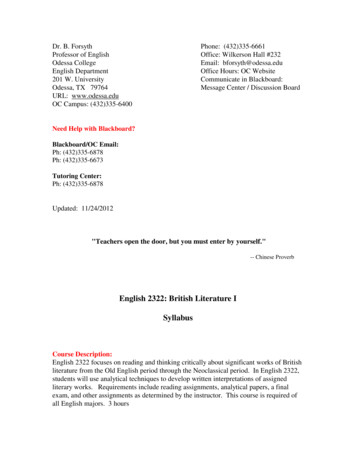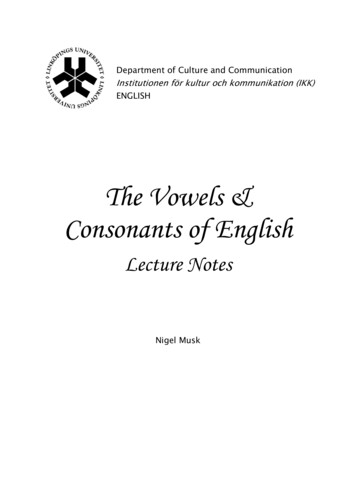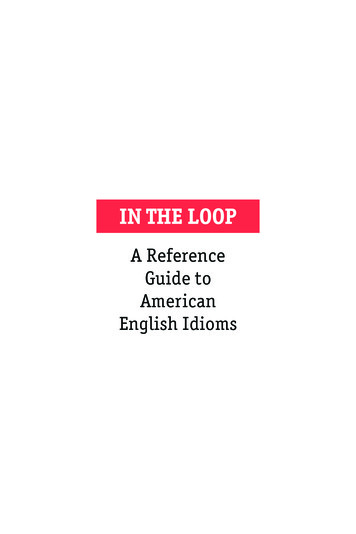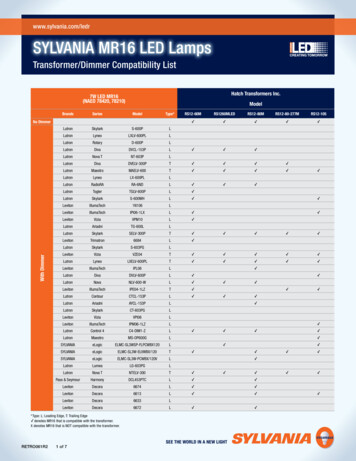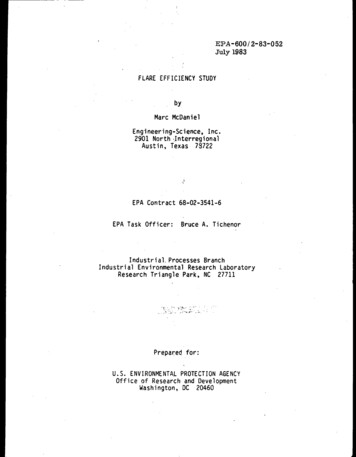
Transcription
British or American English?- An investigation of awareness of the differences in British and Americanvocabulary and spellingAuthor: Christian LindellSupervisor: Stuart FosterExaminers: Stuart Foster, Veronica Brock and Monica KarlssonEnglish Linguistics, Department of Teacher Training (LUT), University of Halmstad
2"I Christian Lindell declare that this work or any part thereof has notbeen previously submitted in any form to the University or to anyother institutional body whether for assessment or for otherpurposes. Save for any express acknowledgements, referencesand/or bibliographies cited in the work, I confirm that theintellectual content of the work is the result of my own efforts andof no other person. Similarly, I take full personal responsibility forany errors or inaccuracies that remain in the content and thelanguage of the text."
3AbstractEnglish has, for some time, been one of the core subjects in the Swedish EducationalEstablishment and the English teaching has successfully enhanced Swedish students’knowledge and competence of the language. The differences between American and BritishEnglish are rarely a subject for consideration though, and the aim in this essay is toinvestigate what abilities, if any, Swedish students possess in order to distinguish betweenAmerican and British English spelling and vocabulary. This essay will contain a limited study,which includes a sample of 97 individuals who attend an upper secondary school inHalmstad. The results are gathered and analyzed with a quantitative method.The conclusion suggests that Swedish students possess some abilities todistinguish between American and British English. However, none of the participants in theinvestigation were able to be consistent in their English use or stick to one specific variety ofEnglish. All participants mixed American and British English and they did so habitually.Because of the limitation of the study, further research needs to be conductedin order to determine whether the findings in this investigation can be supported or not.Similar research could be conducted elsewhere in Sweden with a similar scope or with abroader perspective including pronunciation and grammar.
4Table of Contents1 Introduction . 51.1 Thesis Questions: . 51.2 Scope. 51.3 Structure . 62 Literature Overview . 72.1 First Language Acquisition . 72.2 Second Language Acquisition . 72.3 Defining the Current Perspectives on English . 82.4 English in Swedish Schools . 92.5 Previous Research. 92.6 Differences Between AmE and BrE . 102.6.1Grammar . 102.6.2 Punctuation . 142.6.3 Spelling . 142.6.4 Pronunciation . 152.6.5 Stress . 162.6.6 Vocabulary . 172.7 Implications of L2 Teaching with Multiple Englishes . 203 Methodology . 223.1 Material . 223.2 Instructions . 233.3 Research Groups . 244 Results and Analysis . 254.1 Vocabulary . 254.2 Spelling. 264.3 Previous Influences . 295 Discussion . 326 Conclusion . 366.1 Future Research . 377 Reference List . 388 Appendix 1 - Survey . 40
51 IntroductionIn my experience, English instruction in school has always been emphasized, as Englishwould benefit the individual in the future. Not only would a competent English speaker beable to travel and communicate with speakers from all over the world, but the languagewould also help the speaker to gain access to new cultures. The benefits of becoming aconfident and erudite English speaker in a globalized world offer work-related opportunitiesto which a high level of proficiency in English would be a great asset. I will not argue theopposite; English has given me opportunities which I would not have experienced if I wereonly able to speak Swedish. However, as my own linguistic abilities have graduallyincreased, I have found that English competence is not always as unproblematic as I wastaught to believe. Unsurprisingly, the semantics of Swedish and English differ, but tounderstand how they differ has taken an extensive amount of time. I have had to developmy own strategy by which I could re-visit, and even re-learn, many aspects of English. I foundnew and interesting linguistic features, which is one of the reasons I decided to conduct theresearch in this essay.The varieties of English were rarely a concern during my English languageschooling. Kim-Rivera (2008) acknowledges that English education in Sweden has beenhighly successful over the past years and that Swedish students are generally positivetowards learning English. I am prepared to agree, but the variables that determineproficiency or even native-like use can differ, and competence can be viewed from differentperspectives. I came to realize that I regularly and unknowingly mixed English varieties,especially AmE and BrE (and probably still do). Therefore, I am interested in investigatingwhether Swedish students are aware and consistent in their English use. In the field oflanguage acquisition, I have decided to adopt a sociolinguistic approach to the research. Theinvestigation will examine the level of awareness, and the abilities Swedish students possess,in order to distinguish between AmE and BrE.1.1 Thesis Questions:1. What competence, if any, do Swedish students in upper secondary schoolpossess to enable them to distinguish between BrE and AmE?2. To what extent do the current theories and perspectives on SLA inform us as to students'abilities to distinguish between BrE and AmE?1.2 ScopeThis investigation will include students who, at the time of writing, are attending uppersecondary school in Sweden. Due to the limitation of the research, I have decided toinvestigate four classes in Halmstad. The participants are between 16 and 17 years old andthey are attending their second year in both technical programs and in programs which are
6preparing the students for further academic studies. The research in the investigation willexamine the participants’ abilities to distinguish between standard British English (BrE) andstandard American English (AmE). The primary data will examine vocabulary and spellingonly. Due to time constraints, the primary data will not include grammatical or phoneticaspects, although it will be considered in the discussion.1.3 StructureThe second chapter of the essay, the literature overview, includes a synopsis of the currenttheories of first and second language acquisition, a summary of the current perspectives ofEnglish, previous research in the field and the differences between AmE and BrE in terms ofgrammar, use, spelling and vocabulary. The literature overview will be followed by themethodology in which the population is delineated, the sampling process explained andjustified, and the ways by which my results will be analyzed and interpreted will be outlined.Chapter four contains the results and the analysis of the primary data. The results andanalysis is followed by the discussion. In the discussion, the primary data will be comparedto previous research and discussed on the basis of the thesis questions. The discussion isfollowed by chapter six, which is the conclusion; this will summarize the preceding chapters,the findings of the investigation and the implication of those findings and recommendationsfor further research.
72 Literature Overview2.1 First Language AcquisitionLightbown and Spada (2013) describe the main theoretical positions of first language (L1)acquisition and the theories of their implications. The behaviorist perspective focuses on theencouragement by the speakers’ environment. The ‘positive reinforcement’ of praise oraccomplished communication is substantial for the behaviorists, as language acquisition isbelieved to be achieved through imitation and practice. In contrast to the behavioristicperspective, Chomsky, among others, challenged the behavioristic explanation by arguingthat the theory failed to account for the logical problem of language acquisition. His theoriesare related to the innatist perspective, which proposes human languages to have a preequipped universal grammar (UG). Children have been shown to know more about their L1than what the input has offered them, allowing researchers who study language acquisitionfrom the innatist perspective to hypothesize whether the ability to construct complexgrammatical sentences is instead conferred upon the speaker by the installed UG facility. Inaddition to the innatist and the behavioristic perspectives, cognitive psychologists argue thattoo much emphasis is put on the final state in which a speaker reaches the competence ofan adult native speaker. This theory, namely the interactionist/developmental perspective,focuses on the interplay between the innate learning ability and the environment in whichlanguage is developed. In their view, all essential knowledge is held by the language itselfand is required after continuous interaction with people and objects around the L1 learner.The importance of L1 acquisition is emphasized as a necessary component to understandingthe process of second language (L2) acquisition, as L1 acquisition can affect theimplementation of language acquisition theories in an instructional classroom environment.2.2 Second Language AcquisitionDe Bot, Lowie and Verspoor (2005) call attention to the difficulties of defining what an L2 isand what a foreign language (FL) is, due to the sometimes dynamic relationship betweendifferent languages. L2 acquisition, according to the traditional definition, takes place in asetting in which the language to be learned is spoken in the local community. According tosome definitions of L2 acquisition, the requirement needs to take place outside aninstructional setting. FL acquisition, according to the traditional definition, takes place in asetting in which the language is not spoken or established in the local community. In mostcases, FL acquisition takes place in a setting with formal language instruction.The dynamicsof language is explored with ‘nested systems’. The term refers to how a larger system ofgrammatical and lexical competence can contain smaller systems (sub-systems), involvingchanges in, for example, the vocabularies of speakers. Internal and external factors may,over time, influence speakers to modify their language use. Each individual has their ownvarieties of phonemics, lexical and grammar sub-systems, affected by prior experiences and
8influential social environments. The changes in lexical competence can be affected by suchfactors as prestige and lack of usage.Saville-Troike (2006) explains how language traditionally is divided into vocabulary,morphology, phonology, syntax and discourse. With vocabulary seen as the most importantcomponent when requiring an L2, the communicative competence is divided into academicand interpersonal competence. Saville-Troike’s distinction of vocabulary is based on theintended use of the L2, influenced by the conditions of the learning environment. Thelinguistic competence is viewed from a broader perspective and includes appropriate use inparticular communities. Every individual has their own experiences of language use andcompetence is believed to be connected to culture, context and what content is beingcommunicated in every particular situation.Jenkins (2006) approaches L2 teaching by explaining that the reasons someone chooses toacquire a L2 have changed. Jenkins argues that instructional language learning and the aimfor achieving proficiency are questioned as English has developed into an internationallanguage. This means that the aim of the acquisition is very different, depending on the L2learners’ initial purpose of the L2. Some learners may need an L2 when visiting countrieswhere their first language is not universally spoken and they need to interact with localpeople, while others need a more advanced L2 competence in their work. Such situationcalls upon a broader perspective, while the concept of ‘English as a foreign language’ (EFL) iscompared to the concept of ‘English as a Lingua Franca’ (ELF)1. The transfer of ELF learners’L1 might substantially affect the outcome regarding grammar, syntax or pronunciation, butthe intended goal of the L2 could still be met, even though the L2 competence is far fromadvanced. The L2 could be spoken with, for example, grammatical errors, but it could still beseen as a successful communication as long as the ELF speaker makes himself or herselfunderstood. When an ELF speaker reaches a level of competence where he or she feels thatthe L2 meets the intended communicative purpose, there is a risk that the learner mightexperience fossilization2. When this happens, the ELF learner might abandon any furtherattempts to develop their abilities in the new language beyond what they perceive to be thelevel required for daily conversation.2.3 Defining the Current Perspectives on EnglishJenkins (2006) explains that the term World Englishes (WE) can be viewed from threedifferent perspectives. Firstly, the term can serve as an ‘umbrella label’, also represented asWorld English (in the singular), international English(es), and Global English(es), which coversall varieties of English and the approaches used to analyze them. Secondly, it is used in a1English as a Lingua Franca refers to communicative situations in which no one shares the same mother tongueand has to communicate in a mutual language, in this case, English.2Fossilization is a phenomenon which describes how incorrect language use, when learning a L2, can become ahabit and cannot easily be corrected.
9narrower sense which refers to the so-called “new Englishes” in Asia, Africa and theCaribbean, also represented as nativized3 or institutionalized. Thirdly, it represents thepluricentric approach to the study of English. Although the perspectives sometimes merge,the reference to the interpretations of the terms rarely causes confusion as the intendedreference is a subject of mutual understanding. ELF is sometimes confused with English asan international language (EIL), as it is an alternative term for ELF. The term ELF does notdetermine any unitary variety of English, but is determined by the users; it would be nonnative or native, depending on what researchers choose to ascribe ELF.2.4 English in Swedish SchoolsKim-Rivera (2008) explains that English is a mandatory subject in compulsory school inSweden and, when the new National Curriculum was introduced in 1995, during a process ofdecentralization, every school was given the authority to decide when English instructionwould be introduced to the students. At the time, the main goal was to ensure every studentwas proficient in spoken English. The EFL teaching generally starts in first grade, by focusingon oral skills and English as a world language, which has been highly successful, as the use ofEnglish is widespread in Swedish society with a low number of students who have a negativeattitude towards English as a subject in school.Skolverket4 (2011) introduces the subject English in the Curriculum for Secondary School bystating that “teaching of English should aim at helping the pupils to develop knowledge ofthe English language and of the areas and contexts where English is used * ”, and supportsthe formulation by explaining that the teaching should aim at all-round communicative skills,confidence, and understanding cultural phenomena. All teaching should provide thestudents with knowledge in English and of the conditions and environments in which thelanguage is spoken.2.5 Previous ResearchSkibdahl and Svensäter (2012) researched Swedish students’ attitudes and awareness of fivedifferent English accents and their ability to distinguish them from each other, by invitingparticipants from four different schools to participate in a questionnaire. AmE, BrE, IrE5,IndE6 and AusE7 were investigated and the result was analyzed using a quantitative method.The findings showed that the participants were most aware of AmE and BrE, although theother accents which were included in the research were quite familiar to them as well.3The term refers to a language which has gained native speakers. Such examples were common in formerBritish colonies when inhabitants started to use accented English.4The Swedish National Agency for Education5Irish English6Indian English7Australian English
10When the awareness of the different accents was compared with the accent the participantsbelieved they spoke, a divergence was detected and that was attributed to identity. It wasconcluded that accent is connected with social identity and it is influenced by the situationsin which it is used. Hence, a participant who believes him or herself to be a speaker of a BrEdialect (or accent) will identify himself or herself in situations where BrE normally is spoken.Ledin (2013) investigated attitudes towards AmE and BrE in Swedish upper secondaryschool. The attitudes were compared with the participants’ previous influences and,secondly, compared with two previous studies performed in the field. The findings showedthat most participants claimed they spoke AmE, closely followed by BrE, but the resultshowed that most participants, even those who claimed they spoke BrE, actually used AmE.This was in spite of the fact that most participants stated that BrE was their target accent.Regardless of their intended accent, most participants believed they spoke a mixture of bothAmE and BrE, as the influence of TV and other media were accounted for as the maincontributor to the participants’ mixture of AmE and BrE.Alftberg (2009) investigated whether Swedish students in secondary school used AmE or BrEby researching attitudes, awareness and usage. The participants were given a questionnaireand they read a list of words out loud. The findings showed that all participants used anEnglish with features of both AmE and BrE. Although most participants, particularly the malestudents, had a higher preference for AmE and in general, to a larger extent, were able todistinguish between AmE and BrE. A divergence in vocabulary was detected as ‘schoolrelated’ items were associated with BrE and ‘non-school related’ items were associated withAmE. Aftberg acknowledges that a possible change in attitudes towards AmE and BrE wasapparent in the investigation, as BrE was no longer viewed as the higher prestige variety.2.6 Differences Between AmE and BrE2.6.1GrammarTottie (2002) explains how grammar, as opposed to vocabulary, does not have to change inorder to reflect a changing reality. When new vocabulary is coined and borrowed inresponse to new circumstances and new phenomena, the changes in grammar have beenrelatively few even though there are differences between AmE and BrE. The grammaticalexamples which are normally given are general and not exclusive for either BrE or AmE, thusvariations in dialects and circumstantial use, for instance in conversation, fiction, academicwriting etc., might differ in terms of their construction of grammatical features.Modiano (1996) states that most observers of the English language recognize the differencesbetween AmE and BrE to be found in pronunciation, vocabulary and spelling. However, whilepunctuation seems to be insignificant, grammatical and stylistic differences are more
11extensive and important than most observers initially recognize. Some structures might beaccepted in one variety of English while it is considered ungrammatical in the other,although such grammatical differences rarely impede communication. Seemingly minordifferences do not cause disruptions, but these features are interlinked with the synthesis oflexical choices, pronunciation, spelling etc., which allows communication to proceed withoutmisunderstandings.ArticlesTottie (2002) explains how indefinite articles are used depending on whether it is followedby a vowel sound or a consonant sound, as in a dog, an apple. However, in informal AmE,the indefinite article ‘an’ is replaced with the phoneme /ə/ as in a orange, a area, due to theinfluence of Black English where it is used frequently. Definite article usage differs betweenAmE and BrE. AmE uses the definite article to a greater extent than BrE, as in university andhospital.AmEBrEMy son is at the universityMy son is at universityAmEBrEFred is in the hospitalFred is in hospital(Tottie, 2002, p. 148)Modiano (1996) gives examples of phrases which require a definite article in AmE, but areused without a determiner in BrE; onto grounds (BrE), onto the grounds (AmE), members ofstaff (BrE), members of the staff (AmE), on average (BrE), on the average (AmE). There areconstructions in which BrE has a definite article, as in in the light of these developments,while AmE does not, as in in light of these developments, although both constructions areaccepted in AmE (p. 126).GenitiveTottie (2002) gives the general rule for how the s-genitive is used in both AmE and BrE. Therule of thumb is that animate nouns, particular in the singular, are constructed with the sgenitive, as in the girl’s parents, while other nouns are constructed with the of-construction,as in the color of my car. However, in recent years there has been a noticeable change in theuse of s-genitive in AmE. The development has shown that abstract nouns, such asswimming and jumping, get the s-genitive as well as in the following examples of an Englishnewspaper (Hundt 1997:40):AmEAmEAnita Nall and Summer Sanders – swimming’s “New Kids on the Block”[S]how jumping’s prize money doesn’t yet approach golf or tennis . . .
12NumberTottie (2002) explains how number sometimes varies between AmE and BrE. For instance,AmE speakers tend to prefer the plural form accommodations while BrE speakers use thesingular form accommodation; conversely, AmE speakers say math while BrE speakers saymaths. Noun-noun compounds represent the largest of all categories of new words and adifference in number can be distinguished there as well. In AmE the first noun is generally insingular, as in drug problem, trade union, road policy, chemical plant. In BrE the first noun issometimes in plural, as in drugs problem, trades union, roads policy, chemicals plant.VerbsTottie (2002) explains the differences in verb morphology between AmE and BrE. Withregular verbs the dental suffix is normally realized as [t] after a voiceless consonant, as instopped, as [d] after a voiced consonant, as in mailed, and as [ɪ d] after a dental consonant,as in ended and wanted. There are features of both endings in both AmE and BrE.Modiano (1996) acknowledges the differences in verb forms as perhaps the most significantdissimilarity between AmE and BrE. A number of BrE verbs have a t-inflection while AmEverbs tend to conform to the standardized –ed structure. These differences constitute asubtle distinction in pronunciation which often goes unnoticed in pronunciation, butindicates in which English a text is written. It is worth mentioning that many AmEconjugations are considered Standard English in BrE, thus both versions are accepted ascorrect.AmEburn, burneddwell, dwelledget, gottenlearn, learnedsmell, smelledspell, spelledspill, spilledspoil, spoiledBrEburn, burntdwell, dweltget, gotlearn, learntsmell, smeltspell, speltspill, spiltspoil, spoilt(Modiano, 1996,p. 125)Tottie (2002) shows another class of verbs that are being used with the same pronunciationand spelling patterns. Verbs such as dream, lean, kneel and leap all have a long stem vowelwhich affects the pronunciation pattern in the past tense ending, especially in AmE wheredreamed usually is pronounced [drimd]. Thus verbs as such, with a stem vowel, in past tensein AmE are pronounced with an [i] followed by a [d], while in BrE it is pronounced with an [e]followed by a [t].
13AmE with [i] and [d]BrE with [e] and [t]Dream dreamed dreamed Dream dreamt dreamtKneel kneeled kneeledKneel knelt kneltLean leaned leanedLean leant leantLeap leaped leapedLeap leapt leaptTottie, 2002, p. 151PrepositionsModiano (1996) calls attention to the divergences of prepositions, for example, in BrE ‘therestaurant is in the High Road’ and ‘he was in Paris at the weekend’ while in AmE ‘therestaurant is on the Main Street’ and ‘he was in Paris on the weekend’. Both BrEconstructions are considered peculiar in AmE. Sometimes the contrast can be even morestriking, as in BrE ‘fill in a form’ and in AmE ‘fill out a form’.Tottie (2002) explains how the same prepositions sometimes take different forms in AmEand BrE. Toward is commonly, in BrE, spelled with an -s and among (accepted in AmE andBrE) is spelled with –st, although the form amongst, in BrE, is considered old-fashioned:AmEBrEHe walked toward the entranceHe walked towards the entranceAmE, BrEBrEHe found it among the flowersHe found it amongst the flowers(Tottie, 2002, p. 172)Another example of divergence between AmE and BrE is the two forms of the prepositionaround, as in:AmE, BrEBrEShe walked around the blockShe walked round the block(Tottie, 2002, p. 172)Subject/Verb agreementModiano (1996) explains the many differences in subject concord between AmE and BrE. Forexample, plural nouns as organizations, businesses, official agencies, etc., are often treatedas plural entities in BrE, which means they are given the verb are, whereas in AmE, the samenouns are considered singular and they get the verb is. Implied plurals are similarlyconstructed, for example, in BrE it is acceptable to say ‘the committee are going to issue astatement’ and ‘the government are considering the proposal’, whereas in AmE one wouldsay ‘the committee is going to issue a statement’ and ‘the government is considering theproposal’. In the cases where the plural form is used, it indicates a reference to theindividuals or the sub-groupings in an organization and not the organization itself.
142.6.2 PunctuationModiano (1996) explains some general features in the differences between AmE and BrEregarding punctuation. For example, the hyphens are more frequently used in BrE whenwriting compound nouns whereas, in AmE, they are written with two words; for instance, inBrE co-operation and in AmE cooperation. One of the main diverging features, when writersare dividing a word at the end of a line, is that in BrE the system for dividing a word is basedon the morphological
American and British English spelling and vocabulary. This essay will contain a limited study, which includes a sample of 97 individuals who attend an upper secondary school in Halmstad. The results are gathered and analyzed with a quantitative method. The conclusion sug

